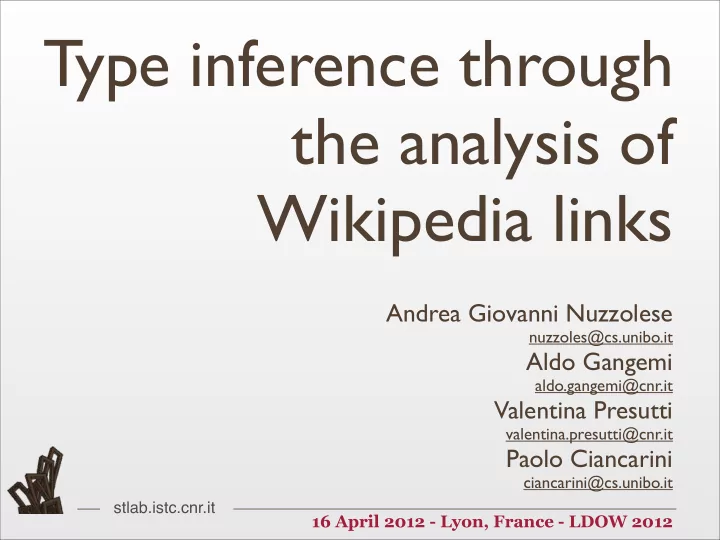

Type inference through the analysis of Wikipedia links Andrea Giovanni Nuzzolese nuzzoles@cs.unibo.it Aldo Gangemi aldo.gangemi@cnr.it Valentina Presutti valentina.presutti@cnr.it Paolo Ciancarini ciancarini@cs.unibo.it stlab.istc.cnr.it 16 April 2012 - Lyon, France - LDOW 2012
Outline • Motivations • Materials • Applied methods • Results • Conclusions stlab.istc.cnr.it 2
Motivations ✦ Only a subset of the DBpedia resources is typed with the Resources used in wikilinks DBpedia ontology (DBPO) relations: ✦ The typing procedure is top- 15,944,381 down. ✦ Is the DBPO complete with respect to the DBpedia domain? ✦ How good and homogeneous Resources having a DBPO type: is the granularity of DBPO 1,518,697 types? stlab.istc.cnr.it 3
Materials Wikilink triples with typed subject/object: DBpedia 3.6 16,745,830 Dataset # of triples Wikilinks wikilink triples 107,892,317 triples: 107,892,317 infobox mapping-based “data” triples 9,357,273 rdfs:label triples 7,972,225 rdf:type triples 6,173,940 DBpedia ontology: infobox mapping-based “object” triples 4,251,239 272 classes stlab.istc.cnr.it 4
What we did • Wikilinks of a DBpedia resource convey knowledge that can be used for classifying it. • Classification methods ✦ Inductive learning: k-Nearest Neighbor algorithm ✦ Abductive classification based on EKPs [1] and homotypes used as background knowledge • The methods were performed on Resources having a Resources used in wikilinks DBPO type: relations: Sample of 1,518,697 15,944,381 untyped resources: 1,000 [1] A. G. Nuzzolese, A. Gangemi, V. Presutti, and P . Ciancarini. Encyclopedic Knowledge Patterns from Wikipedia Links. In L. Aroyo, N. Noy, and C. Welty, editors, Proceedings of the 10th International Semantic Web Conference (ISWC2011), pages 520-536. Springer, 2011. stlab.istc.cnr.it 5
Inductive classification • We designed two inductive classification experiments based on the k -NN algorithm ✦ on 272 features, i.e., all the classes in the DBPO ✦ on 27 features, i.e., the top-level classes in the DBPO hierarchy • For each experiment we built a labeled feature space model as training set by using a randomly sampled 20% of typed resources ✦ the algorithms were tested on the remaining 80% of typed resources stlab.istc.cnr.it 6 5
Building the training set for K-Nearest Neighbor algorithm dbpedia:Apple_Inc. dbpedia:NeXT dbpo:wikiPageWikiLink dbpedia:Steve_Jobs dbpedia:Forbes dbpedia:Cupertino,_California Mammal Scientist Company Drug City Magazine Class dbpedia:Steve_Jobs ... stlab.istc.cnr.it 7
Building the training set for K-Nearest Neighbor algorithm dbpo:Organisation dbpedia:Apple_Inc. dbpedia:NeXT dbpo:wikiPageWikiLink rdf:type dbpedia:Steve_Jobs dbpo:Magazine dbpo:City dbpedia:Forbes dbpedia:Cupertino,_California dbpo:Person Mammal Scientist Company Drug City Magazine Class dbpo:Person dbpedia:Steve_Jobs ... stlab.istc.cnr.it 7
Building the training set for K-Nearest Neighbor algorithm dbpo:Organisation dbpo:Magazine dbpo:City dbpo:wikiPageWikiLink rdf:type kp:linksTo dbpedia:Steve_Jobs Mammal Scientist Company Drug City Magazine Class 1 1 dbpo:Person dbpedia:Steve_Jobs 0 0 0 1 ... stlab.istc.cnr.it 7
Building the training set for K-Nearest Neighbor algorithm dbpo:Organisation dbpo:Magazine dbpo:City dbpo:wikiPageWikiLink rdf:type kp:linksTo dbpedia:Steve_Jobs Mammal Scientist Company Drug City Magazine Class 1 1 dbpo:Person dbpedia:Steve_Jobs 0 0 0 1 ... ... ... ... ... ... ... ... stlab.istc.cnr.it 7
Building the training set for K-Nearest Neighbor algorithm dbpo:Organisation dbpo:Magazine dbpo:City dbpo:wikiPageWikiLink rdf:type kp:linksTo dbpedia:Steve_Jobs ✦ Precision using all DBPO types as features: 31.65% ✦ Precision using the top-level of DBPO as features: 40.27% stlab.istc.cnr.it 7
Abductive classification with EKPs • EKPs ✦ A EKP of a certain entity type is a small vocabulary that captures the core types used for describing such entity type as it emerges from the Wikipedia crowds visit aemoo.org for an exploratory tool based on EKPs stlab.istc.cnr.it 8
How can we infer the type of “Galileo Galilei”? http://www.aemoo.org stlab.istc.cnr.it 9
How can we infer We know its path types the type of “Galileo Galilei”? http://www.aemoo.org stlab.istc.cnr.it 9
We compare the path types involving We have 231 EKPs “Galileo Galilei” as subject with EKPs in order to identify the most similar, which is the "Scientist" EKP . http://www.aemoo.org stlab.istc.cnr.it 9
The inferred type for the resource “Galileo Galiei” is the class “Scientist” http://www.aemoo.org stlab.istc.cnr.it 9
Distinctive weakness of some EKPs ✦ The distinctive weakness seems due to wide overlaps among some EKPs ✦ Systematic ambiguity of the 4 largest classes ✦ Precision and recall on all DBPO types both 44.4% ✦ Precision and recall on the top-level of DBPO hierarchy: 36.5% and 79.5% stlab.istc.cnr.it 10
Homotype-based abductive classification • Homotypes are wikilinks that have the same type on both the subject and the object of the triple dbpedia:Plato dbpo:Philosopher dbpedia:Immanuel_Kant dbpo:Philosopher rdf:type rdf:type dbpo:wikiPageWikiLink • We have observed how the homotype is usually the most frequent (or in the top 3) wikilink type • Given an untyped entity, we hypothesize that the most frequent type involved in its ingoing/ outgoing wikilinks detects its homotype, hence it indicates its type 11 stlab.istc.cnr.it
Homotype-based abductive classification s stlab.istc.cnr.it 12
Homotype-based abductive classification s stlab.istc.cnr.it 12
Results on classifying already typed resources stlab.istc.cnr.it 13
Results on untyped resources • Results on a sample of 1,000 untyped resources are much less satisfactory With EKPs With Homotypes stlab.istc.cnr.it 14
Why? [1] • Typed entities: 2:3 typed wikilinks ratio • Untyped entities: 1:3 typed wikilinks ratio • Link structure for untyped entities is not rich enough stlab.istc.cnr.it 15
Why? [2] • DBPO does not provide a complete set of classes for correctly typing DBpedia resources dbpedia:List_of_FIFA_World_Cup_finals Collection dbpedia:Computer_Science ScientificDiscipline dbpedia:Counterattack Plan dbpedia:Eros(concept) Concept dbpedia:Gentlemen’s_agreement Agreement stlab.istc.cnr.it 16
Conclusions • We have investigated different approaches for typing DBpedia resources based on the data set of wikilinks • Results are acceptable in the test set, but extensive untypedness in output links, and poor DBPO coverage severely compromise automatic typing for untyped resources • We have analyzed possible causes deriving from some bias in DBpedia 17 stlab.istc.cnr.it
Future work • Yago could be helpful but ✦ there is a lack of mapping between YAGO and DBPO ✦ it has larger coverage and only an overlap with DBPO ✦ the granularity of its categories is finer, and not easily reusable, because the top level is very large stlab.istc.cnr.it 18
Thank you Andrea Nuzzolese - STLab, ISTC-CNR & Dipartimento di Scienze dell’Informazione University of Bologna Italy stlab.istc.cnr.it 19
Recommend
More recommend